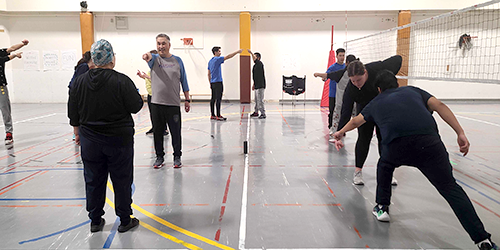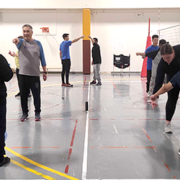Government of Nunavut unveils Aulajuq: Nunavut Physical Literacy in collaboration with Sport for Life
 In the heart of Iqaluit this November, Sport for Life’s Mataya Jim and Greg Henhawk played a pivotal role at the Government of Nunavut’s annual sport and recreation conference. Attendees from communities across Nunavut, including coaches, teachers, and recreation staff, collaborated around the theme of ‘More Sport, More Active, More Often.
In the heart of Iqaluit this November, Sport for Life’s Mataya Jim and Greg Henhawk played a pivotal role at the Government of Nunavut’s annual sport and recreation conference. Attendees from communities across Nunavut, including coaches, teachers, and recreation staff, collaborated around the theme of ‘More Sport, More Active, More Often.
“It was a great turnout, with participants from all over Nunavut!,” Jim exclaimed. “It was a great partnership between Sport Nunavut and the Government of Nunavut in terms of their presentation and the pathways they outlined for the conference itself.”
Jim and Henhawk’s sessions took a unique spotlight, serving as the platform for unveiling the Government of Nunavut’s Aulajuq: Nunavut Physical Literacy activity cards and guide, a collaboration with Sport for Life. The practical session underscored the importance of physical literacy at the FUNdamental and Active Start stages and marked the debut of a valuable print resource in Nunavut.
Physical literacy tailored to the community
The Aulajuq resources, a project started several years ago by the Government of Nunavut, are designed to bring physical literacy into daily life in a structured and engaging manner. They feature:
- Diverse Activities: A variety of activities that explore balance, locomotor, and object control skills.
- Lesson Planning Support: Practical tips on planning lessons that focus on physical literacy, along with a customizable lesson plan template,
- Cultural Connection: A list of Inuit societal values and their integration into physical literacy, fostering a connection to traditional values.
- Cultural Games: The cards showcase games that highlight Inuit culture and traditions, creating a bridge between physical activity and cultural appreciation.
The cards are available in Nunavut’s four official languages, including Inuktitut, Inuinnaqtun, English, and French, making them more accessible across Nunavut communities. Combining local language with Inuit societal values makes them particularly relevant to Northern communities. Particularly since Inuktitut is the mother tongue of 61.7 percent of Nunavut’s population in 2021, according to Statistics Canada.
“There are so many resources specific to the south; content is very south-oriented. When we look at the Indigenous Long-Term Participant Development Pathway, there’s a distinction between mainstream and Indigenous aspects of sport or ways of doing things. When you’re in the territories, it’s more of a dichotomy between the north and south and the different societal values and ways of living that come into play a bit more between those regions,” Jim explained. “So having those in the cards and connected to the societal values is very useful.”
Going forward, the Government of Nunavut will prioritize distributing the cards within the communities they work with as physical handouts for local recreation leaders and coaches.
Looking beyond typical, sport-specific drills
Jim and Henhawk also provided important insight and ideas for conference participants about making the activity cards sport-specific. For example, Jim and Henhawk introduced line tag as an activity in their basketball session, where players also had to dribble a ball and change dribbling hands when they dribble over a line.
They also incorporated information on the characteristics of physical literacy-enriched environments: fun, with purpose, everyone included, always moving, and progressive and challenging.
“Greg did really well in terms of working his magic and adding those helpful coaching pieces to support coaches and their development,” Jim said. “The laughter and all the coaches, these adult coaches, just having a good time playing those games and activities with folks from other communities—some coaches they knew, some they didn’t—it was just like a really great way to engage with the cards and engage in learning and coach development.”
Tangible takeaway
Coaches are encouraged to think creatively about incorporating sports-specific skills into various activities and games like tag, emphasizing that not all training needs to be drill-oriented for sports! Considerations for age-appropriate activities, warm-ups, and cooldowns are also essential.

